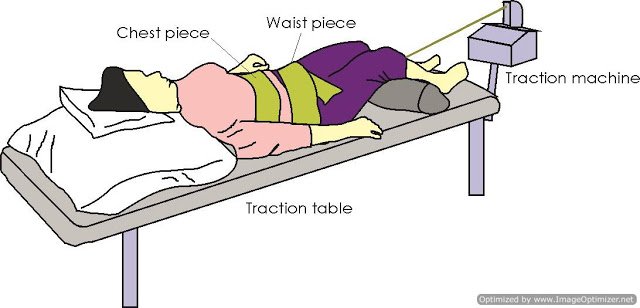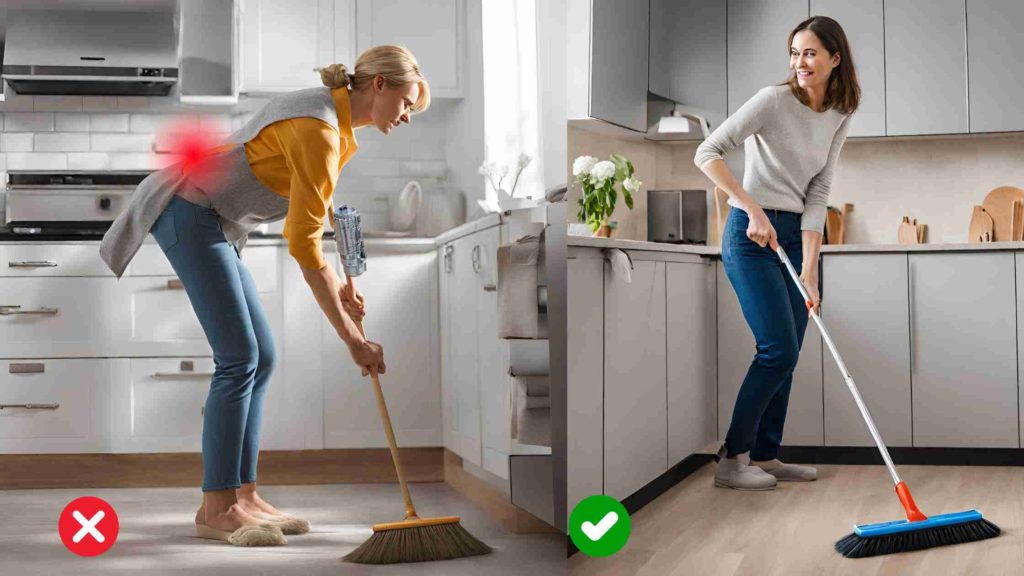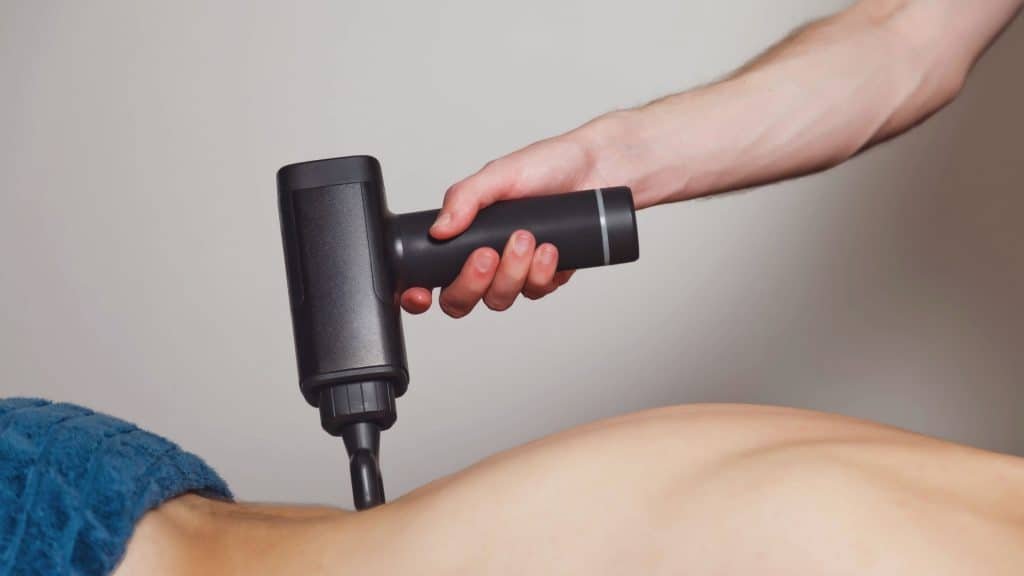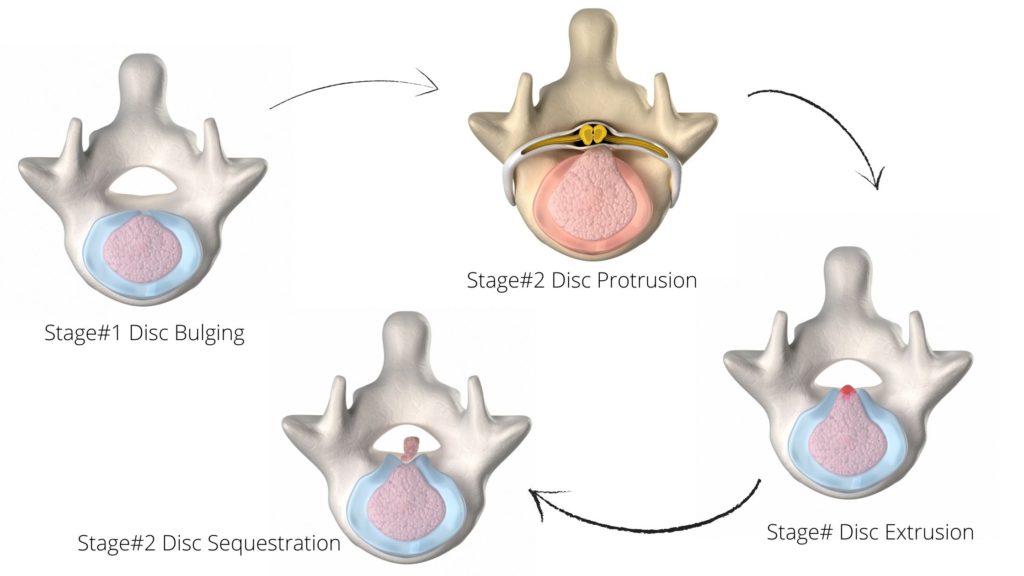Last updated on March 28th, 2025 at 06:23 pm
The lumbar traction technique helps relieve back pain without medication, and it can also cure complicated pain cases such as sciatica and disc hernia, which would otherwise require painful surgery.
It is an essential part of the physiotherapy treatment process. In this post, we will explain the basic principle of traction using lumbar traction as an example. So, let’s get started.
Table of Contents
What is lumbar traction physiotherapy?
Traction is a broad term that involves applying a distraction to a body part using weight or mechanical pull. When traction is applied to the lumbar area using a traction machine, it is called lumbar traction.
Traction is commonly used for neck pain, knee pain, and low back pain. It is also used for the leg after a leg bone fracture and for the hip bone after a femur neck fracture.
However, in this context, we are only concerned with lumbar traction for the lower back.
This is how we can define spinal traction:
Traction is the application of distraction force over the vertebrae to separate two vertebral bodies from each other. In lumbar spinal traction, the pull is applied over the lower back.
How lumbar traction is applied
With time, there has been a significant improvement in the methods of traction application. Slowly, it has evolved towards a more automated and mechanical way, where the force of pull and its duration of application are under control.
We can easily change the duration and its force with a button.
Manual lumbar traction
In the past, a different method was used for spinal traction. It involved using weights such as sandbags and bricks that utilized gravity to create a pulling force.
To perform this method, the individual would lie flat on a bed while wearing a lumbar belt with hooks on either side to attach the rope. On the other end of the rope, a calculated weight was hung, creating a pulling force on the back for 20 to 30 minutes.
However, this method had its downsides. Continuous traction for 20 to 30 minutes could sometimes worsen the pain due to muscle soreness. Personally, I do not use manual traction in my practice.
Mechanical traction
The development of a mechanical traction device was driven by the need to avoid continuous pulling. A mechanical traction unit consists of a machine with motors attached to a couch or table that creates a pulling force.
The pulling force can be easily controlled through the unit’s control system. One of the most significant benefits of this kind of traction is that it allows for the option of choosing between continuous traction and interrupted traction. In my clinical practice, I prefer interrupted traction over continuous mode.
When using lumbar traction, it is important to carefully choose the weight based on the person’s body weight, and the calculation is straightforward.
- NATURAL DISCOMFORT RELIEF. Try natural discomfort relief for a host of back problems such as herniated discs, spondylosi…
- EASY TO ADJUST. This patented product comes with contouring adjustable upper and lower belts for a custom fit that secur…
- FASTER RESULTS. ComforTrac provides simple lumbar decompression for those who have compression of the spine. This tool p…

Lumbar traction parameters: How to calculate traction weight/force
The obvious question is, how much weight is safe and effective?
Every person that comes to you will differ in terms of weight, height and build. The weight that may be effective for one may be too weight or too little for another. You need to calculate the weight for each and every different person.
Thankfully, calculating weight is not difficult. There is a rule of thumb according to which the weight of pull for lumbar traction would be 1/3rd the weight of the
Research shows that 30% and 60% of the body weight as the force of traction significantly improved the mobility of the lower extremity during the SLR (Straight Leg Raise) test in a group of ten subjects with subjective complaints of low back pain or radicular symptoms with a positive unilateral SLR test below 45′1.
Note: The weight of pull for neck/ cervical traction is 1/7th of the weight of the body.
For example, if a person weighs 65 kg, then the force of pull would be roughly 1/3rd of 60 kg, which would be 21.5 kg. So, in this situation, 25 kg would be ideal.
More on mechanical lumbar traction
Continuous pull produces muscle soreness but what when we interrupt it for a short duration of the relaxing period?
Let me be a little more specific with this example. Let’s take the total duration of the pull as 10 minutes. So in interrupted traction, every 40 seconds, there is an interruption of 10 10-second relaxing periods.
This is only possible in this mechanized way. The mechanized traction unit consists of a motorized traction machine, a bed, one chest piece belt, and a low back piece belt.
The illustration below shows all the important parts, the

It has a control button from where we can control the hold time (traction) and release time (relaxation) depending on the nature and severity of the case. The detail on this topic is beyond the scope of this article.
How to apply lower back traction at home
Is it possible to get the benefit of lumbar traction physical therapy at home?
Yes! It is possible. You can use the lumbar traction kit specially designed for the home. Just take care of how much weight /force you are using to apply force. Start with low weights and then progress.
Final word
Traction is widely used for treating low backache. This is why you are sure to find it inside every physiotherapy centre. But, not all
The above post is for information purposes only. You should always go for this procedure under the supervision of a qualified physiotherapist only.
Keep reading: 3 Best sleeping position for sciatica for quick relief
The author is a physiotherapist who has been practising for the last 17 years. He holds a Bachelor's in Physiotherapy (BPT) from SVNIRTAR (Swami Vivekananda National Institute of Rehabilitation and Research), one of the prestigious physiotherapy schools in India.
Whatever he learns dealing with his patient, he shares it with the world through blogs and e-books. He also owns a YouTube channel, "Sunit Physiotherapist" with over 8 lakh active subscribers. Here, he shares everything he gets to learn serving the patient.







Glad that you are improving with your pain
Mechanical traction is helping me, I have disc bulge between l5-s1, that is compressing nerve root. In physical therepy they used your method above, but it is 60 seconds on, 20 off. The pull was much higher though, started at 150 lbs and after several weeks worked up to 180 lbs. (I am 240 lbs) much higher than your 1/3 calculation. I am sore afterwords but it is hel
Ing to relieve the pain and nerve root complications (avoiding the surgery that was recomended)
Pingback: Physical Therapy for Sciatica Nerve Pain - Physiosunit
Hey, awesome site. I came across this on Google, and I am pleased. I will be definitely coming back here more often. Wish I could add the conversation and bring a bit more to the table, but am just taking in as much info as I can at the moment. Thanks for sharing. miss me tablet
Keep Posting:)
great article!!!!!This is very importent information for us.I like all content and information.I have read it.You know more about this please visit again.
SensualKart Flavoured Lubricant